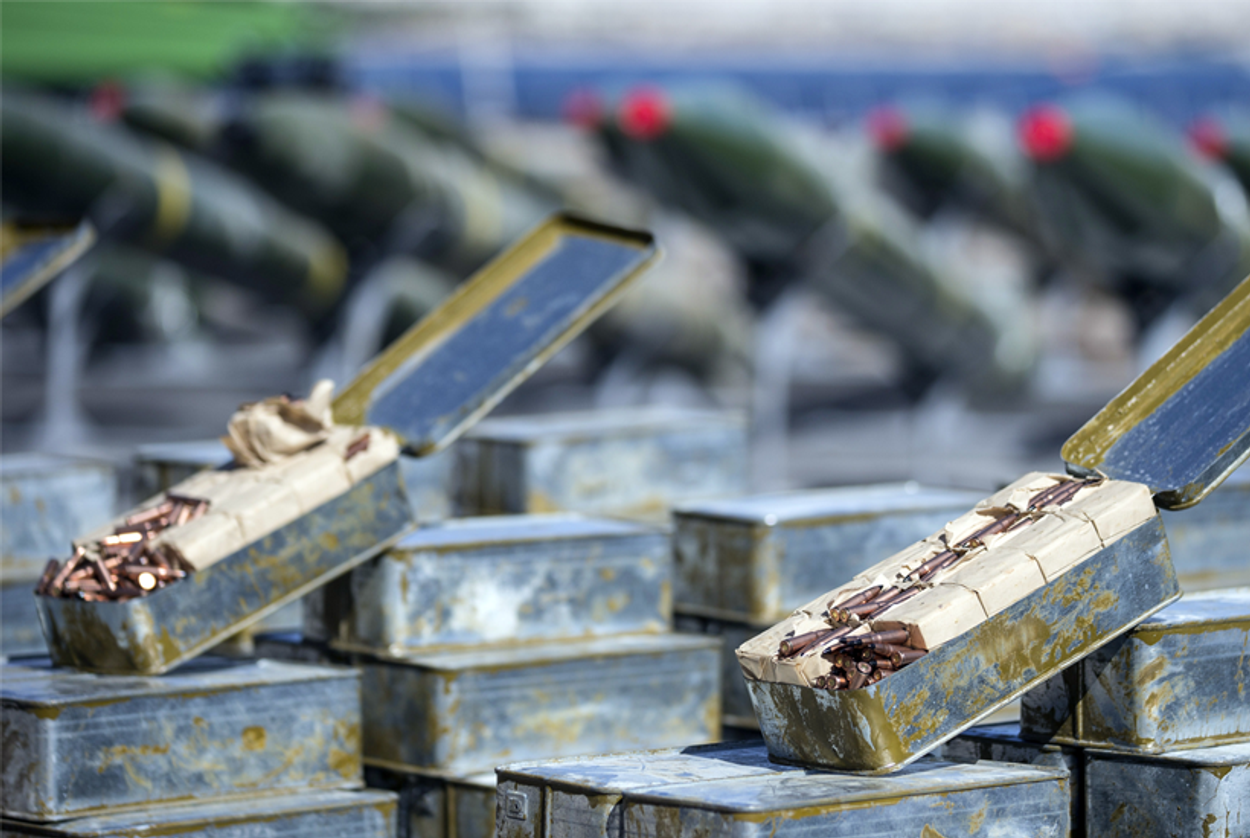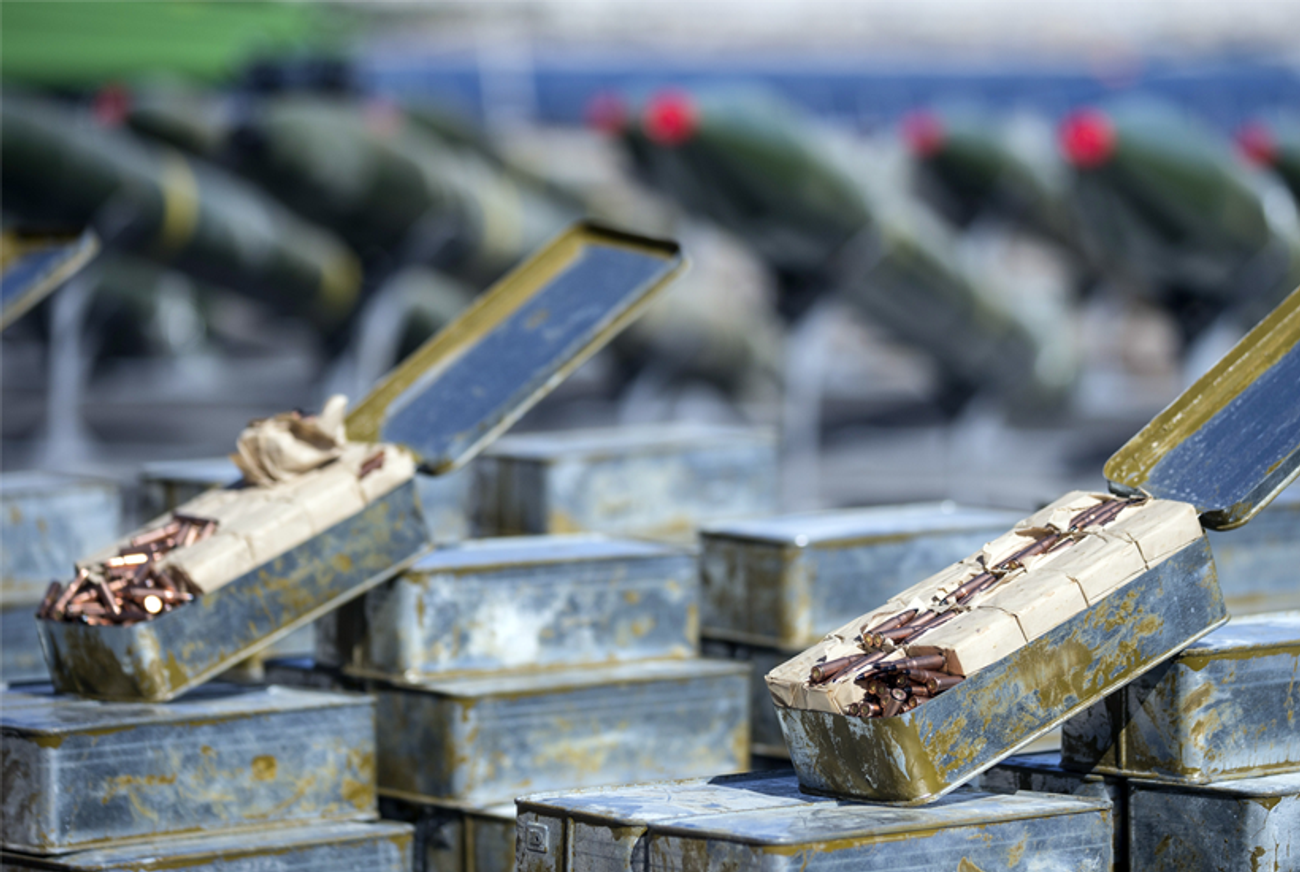Iran’s Ramped-Up Cold War With Israel Is a Sign of Tehran’s Weakness, Not Strength
As the war in Syria deepens sectarian splits among Muslims, Iran’s choice to send rockets to Gaza is a sign the emperor has no clothes




This week, when Israeli Prime Minister Benjamin Netanyahu inspected a cache of Iranian arms seized earlier this month from a Gaza-bound ship, he told the TV cameras accompanying him that the array of rockets represented “the true face of Iran.” In a way, he was right: Tehran is months into negotiations over limiting the scope of its nuclear program in exchange for relaxing international sanctions but still decided to risk sending a shipment of advanced weaponry to terrorists in Israel’s backyard.
But the cargo wasn’t evidence of Tehran’s incorruptible commitment to destroying the Jewish state. Rather, it was a window into the dynamics of intra-Muslim politics—and a sign that Iran is actually a weakened power desperately trying to hold on to regional influence among its Muslim neighbors and allies. It is telling that both the rockets on the ship, as well as the rockets fired into Israel over the past few days, are being tied not to Hamas, a fair-weather ally of Tehran and the undisputed power in Gaza, but rather to the much smaller Palestinian Islamic Jihad.
A look across the region today suggests that Iran’s primary friends are essentially the same small group of proxies and allies it had a quarter-century ago: Palestinian Islamic Jihad, Hezbollah, and the Assad regime in Syria. That is a problem for Iran, which invested years in the aftermath of the Cold War trying to expand its authority as a Muslim power and establish itself as a credible opponent of the United States.
As recently as the 2008 Gaza War Iran could claim real pull among Sunni leaders. But now, as the brutal civil war in Syria has inflamed sectarian rivalries in the region, Iran finds itself relegated to enemy status in the growing ranks of Sunni extremists and increasingly toxic to the Gulf monarchs and others trying to maintain their hold on power in the wake of the Arab Spring.
The demonstrated commitment of the Obama Administration, and the rest of the P5+1, to negotiating with Iran on its nuclear program makes it look like a global player, but Tehran knows it needs to win points on the Arab street—and so it has fallen back on the one time-tested, foolproof strategy it has for winning popular affection among its Sunni Arab neighbors: threatening Israel.
***
In October 1991, with the Cold War firmly decided in favor of the United States, the George H.W. Bush Administration convened the Madrid Conference, ostensibly the launching point for peace negotiations between Israel and its Arab neighbors. But the conference also held significance as an assertion of America’s new role as the world’s unrivaled hegemon and of Washington’s willingness to seize the initiative and assert its interests.
The United States was not the only country trying to seize the moment in hope of reshaping the Middle East. A week before the Madrid gathering, Iran attracted 400 participants from 45 countries to the International Conference to Support the Islamic Revolution of the People of Palestine. It was not the first attempt by Iran to use a call for jihad against Israel to rally Muslims, nor was it even the only country to convene a conference calling for jihad that year; Iraq, under the leadership of Saddam Hussein, did so as well. But the timing of the Tehran conference so close to the Madrid conclave helped make it far more successful than any previous attempt.
Iran spared no expense on the conference, budgeting $20 million originally but spending closer to $100 million, and the attendees came from across the Muslim world. Some were key Iranian proxies, including Sayyed Muhammad Hussein Fadlallah and Abbas al-Musawi from Hezbollah in Lebanon, and Fathi al-Shiqaqi from Palestinian Islamic Jihad. Also in attendance were representatives from Syria, the PLO, and Algeria, who hoped their presence would deflect some of the popular criticism of their participation in the Madrid Conference—and prevent the Tehran conference from being too explicit in its condemnation of them as Western collaborators.
But it was the presence of Sunni Islamists from across the Middle East and beyond that conferred legitimacy on the conference among Islamist activists and cemented its long-term legacy for Tehran. In its desire to gain influence in the Middle East, post-revolutionary Iran has always struggled to bridge the sectarian divide. In 1991, the memory of the decade-long Iran-Iraq War, in which the vast majority of Sunni Islamists staunchly backed Iraq, was still fresh. But a combination of fury over the Madrid Peace Conference and the sense of betrayal stemming from Saudi Arabia’s decision to call in foreign troops during the Gulf War left an opening for Tehran.
Jordanian Islamists were especially well-represented. Among the prominent Islamists in attendance were Abd al-Rahman Khalifa, general supervisor of the Muslim Brotherhood in Jordan, and Abd al-Latif Arabbiyat, the Islamic speaker of the Jordanian Parliament. They were joined by representatives from the Egyptian Muslim Brotherhood, various groups from countries such as Sudan and Afghanistan, and perhaps most important, Hamas. Iran knew that if it were to make real inroads in Palestinian society, it needed to court Hamas. Though fully committed to the ideals of the Iranian Revolution, Palestinian Islamic Jihad could not come close to competing for popularity with Hamas on the Palestinian street.
The Iran-Hamas alliance was certainly not preordained. Prior to the Gulf War, Hamas had mostly shunned Iranian support, given Tehran’s ties to Palestinian Islamic Jihad, Hamas’ rival in Gaza. During the Gulf War, Hamas remained somewhat ambivalent, stuck between needing to support Kuwait, a financial supporter of Hamas, against Saddam’s invading forces, and wanting to cheer Saddam’s Scud attacks on Tel Aviv. (It didn’t help that supporting Saddam also would have put Hamas on the same side as Yasser Arafat and the PLO, its primary enemy within Palestinian society.) While Hamas had sent delegates to a similar 1990 conference in Tehran, it was not until after the Gulf War and the beginning of the Peace Process that Hamas and Iran began to see the potential for a mutually beneficial relationship.
Hamas spokesman Ibrahim Ghawsha’s attendance at the Tehran conference set in motion a series of events that would build the foundations of the Iran-Hamas alliance. While in Tehran, Ghawsha had the opportunity to meet with President Rafsanjani and praised Iran’s support for the “holy ideals of Palestine” and submitted a report on the latest developments in the Islamic uprising in Palestine. Rafsanjani responded by urging all the Muslim world to support the uprising.
The October meeting in Tehran led to a follow-up meeting between Iran and Hamas at a January 1992 conference in Damascus that brought together members of the rejectionist camp to oppose Fatah’s policy of engaging in peace negotiations with Israel. The relationship continued to grow during an October 1992 visit to Tehran by a Hamas delegation led by Musa Abu Marzuq, who met with the Supreme Leader Ayatollah Khamenei. It was reported that Iran pledged $30 million annually to Hamas, as well as making a promise to provide training at camps in Iran, Lebanon, and Sudan. Iranian contributions to Hamas ranged from $20 million to $50 million annually throughout the 1990s.
The final piece of the puzzle that built the early Iran-Hamas relationship was Israel’s deportation of 415 Palestinian Islamic activists to Lebanon in December 1992, including notable leaders such as Abd al-Aziz al-Rantisi, Ismail Haniyya, and Mahmud al-Zahar. Whether Israel was right or wrong to use deportation as a counterterrorism policy, it unwittingly delivered the Hamas activists right into the arms of a waiting Hezbollah, Tehran’s most loyal and capable proxy.
Neither the conference in Tehran in 1991, nor the set of meetings and events over the 14 months that followed created the full-blown Iran-Hamas alliance that thrived in the first decade of the 21st century. But they did plant the seeds of an effective relationship, put a public face on Iran’s play for influence throughout the region, stake Iran’s claim as the leader of the anti-Israel camp, and give Iran a real foothold among Sunni Islamists. As Elie Rekhess, an expert in Palestinian affairs, has described it, “From that point onwards the cooperation and coordination between Iran and the Palestinian Islamic movement became tighter and more pronounced. Both parties, Hamas on the one hand and the Iranians on the other, united in pursuing a joint political goal, to foil the peace process. Iranian influence on the Palestinian Islamic militants became more visible and salient.”
But influence is not static; what was gained in the early 1990s can and to some extent has been lost. In 2006, Hezbollah leader Hassan Nasrallah was one of the most popular leaders in the Middle East after Hezbollah’s impressive showing in its war with Israel. During the 2008-2009 Gaza War, Iran was credited with helping Hamas sustain a two-week offensive against Israel. But since the start of the Syrian War, Iran has come to be almost exclusively viewed as a crutch for Assad—which means Tehran is implicated in the slaughter of the Sunnis fighting the Alawite regime. Nasrallah, who lent his support to Assad, is now reviled, as many question what fighting in Syria has to do with Hezbollah’s mission of resistance against Israel. With sectarianism now raging across Lebanon, Syria, and Iraq, it is becoming nearly impossible for Iran and its proxies to be viewed in outside of this context. Sunni Salafists fighting in Syria now regularly refer to their Shiite opponents by all sorts of derogatory terms meant to dehumanize them—exactly the opposite of the image Tehran wants to project.
Were Iran to attempt to rally supporters to Tehran today, for the Palestinian cause or for anything else, it is unlikely many outside of the Iran-Syria-Hezbollah-Palestinian Islamic Jihad axis would show up. The leadership knows that, and with so much in the Middle East, it was inevitable that the battle against Israel would heat up again, because it’s the only hand Tehran has left to play.
***
Like this article? Sign up for our Daily Digest to get Tablet Magazine’s new content in your inbox each morning.
Josh Nason recently received his master’s degree in Middle East Studies at Johns Hopkins School of Advanced International Studies.
Josh Nason recently received his master’s degree in Middle East Studies at Johns Hopkins School of Advanced International Studies.